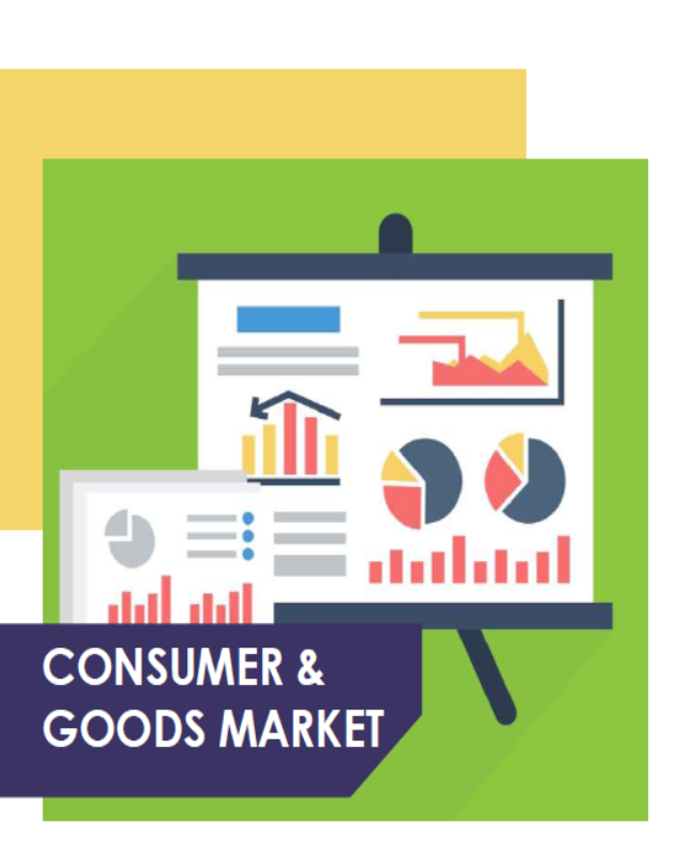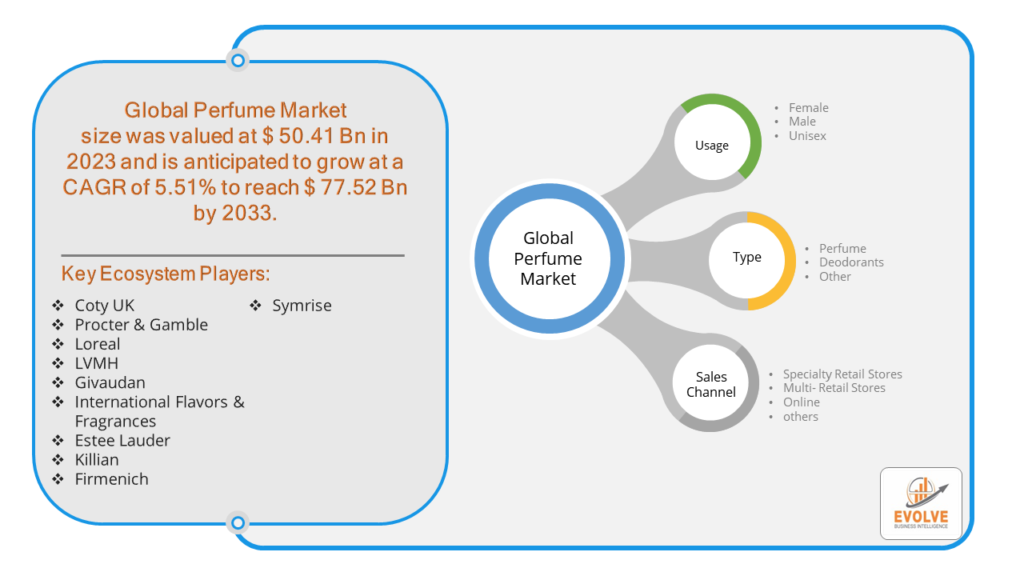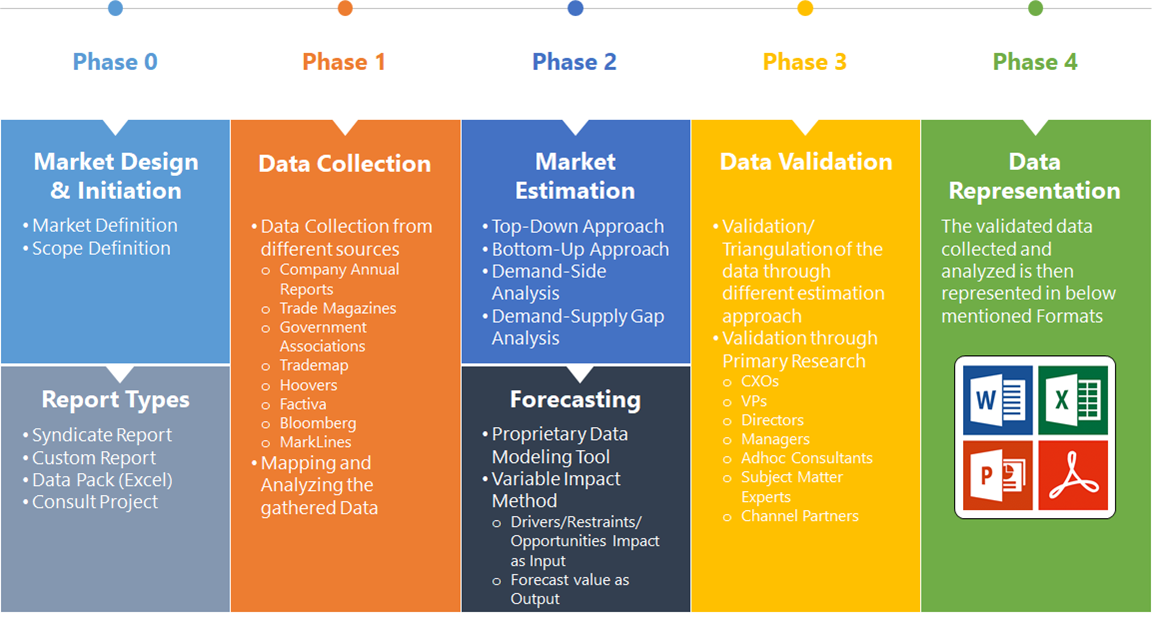Perfume market Overview
The Perfume market Size is expected to reach USD 77.52 Billion by 2033. The Perfume market industry size accounted for USD 50.41 Billion in 2023 and is expected to expand at a compound annual growth rate (CAGR) of 5.51% from 2023 to 2033. The perfume market is the global industry for perfumes and fragrances. It encompasses the creation, marketing, and sale of these scented products. Perfumes are a type of cosmetic product that uses aromatic compounds to create a pleasant scent on the body. They are typically applied to pulse points, such as the wrists, neck, and behind the ears.
The perfume market is a large and complex industry, with a wide variety of products and brands available to consumers. Economic factors, cultural trends, and regulatory policies also play significant roles in shaping the dynamics of the perfume market.
Global Perfume market Synopsis
The COVID-19 pandemic had a significant impact on the perfume market. During the height of the pandemic, sales of non-essential items, including perfumes, declined as consumers prioritized essential goods. Lockdowns, store closures, and reduced consumer spending power contributed to this decrease. With physical stores closed or operating under restrictions, there was a significant shift to online shopping. Perfume brands and retailers had to enhance their digital presence and e-commerce capabilities to reach consumers. The pandemic altered consumer behavior and preferences. There was a shift towards wellness and self-care products, with consumers seeking comfort and stress relief through fragrances. Additionally, there was increased interest in home fragrances as people spent more time at home. The pandemic heightened awareness about sustainability and ethical practices. Consumers increasingly favored brands that demonstrated social responsibility and sustainable practices in their operations.
Perfume market Dynamics
The major factors that have impacted the growth of Perfume market are as follows:
Drivers:
Ø Consumer Preferences and Trends
Perfumes are often influenced by fashion trends and lifestyle choices, with consumers seeking new and unique scents that reflect their personal style. Celebrity endorsements and collaborations can significantly boost sales by attracting fans and creating buzz around new launches. Continuous innovation in scent formulations, including the use of natural and exotic ingredients, helps attract and retain consumers. Offering personalized fragrances and customizable products allows consumers to create unique scents tailored to their preferences. Advances in fragrance technology, such as long-lasting scents and sustainable production methods, appeal to environmentally conscious consumers. Use of AI and data analytics to understand consumer behavior and preferences helps brands create targeted marketing strategies and product offerings.
Restraint:
- Perception of High Competition
The market is highly competitive with numerous established brands and new entrants, making it difficult for companies to maintain market share and brand loyalty. Intense competition can lead to price wars, reducing profit margins for companies. Consumers may shift towards alternative products like body mists, scented lotions, or natural and organic fragrances, reducing demand for traditional perfumes. Growing awareness of potential health risks associated with synthetic chemicals in perfumes can lead to a preference for natural and organic products, posing a challenge for traditional fragrance brands.
Opportunity:
⮚ E-commerce Expansion and Sustainable
The shift towards online shopping provides an opportunity to reach a broader audience and expand market presence. Brands can enhance their digital platforms, offer virtual try-on experiences, and leverage social media for marketing. Offering subscription boxes or personalized fragrance delivery services can cater to consumers looking for convenience and new experiences. There is growing demand for sustainable, eco-friendly, and ethically sourced products. Brands can invest in green chemistry, biodegradable packaging, and cruelty-free certifications. The trend towards natural and organic products presents an opportunity to develop fragrances with natural ingredients, appealing to health-conscious consumers. Innovative, eco-friendly packaging solutions, such as refillable bottles and recyclable materials, can attract environmentally conscious consumers. Incorporating technology, such as QR codes or augmented reality, into packaging can enhance the consumer experience and provide additional product information.
Perfume market Segment Overview
By Usage
 Based on Usage, the market is segmented based on Female, Male and Unisex. The Female segment dominated the market, accounting for 35% of market revenue. In developing economies, category growth is driven by the growing spending power of women on cosmetic products.
Based on Usage, the market is segmented based on Female, Male and Unisex. The Female segment dominated the market, accounting for 35% of market revenue. In developing economies, category growth is driven by the growing spending power of women on cosmetic products.
By Type
Based on Type, the market segment has been divided into the Perfume, Deodorants and Other. The Perfume segment dominant the market. High-end products typically associated with prestigious brands such as Chanel, Dior, and Gucci. These perfumes often feature complex scent profiles and use high-quality ingredients. Artisanal and exclusive fragrances produced by smaller, independent brands. They often focus on unique, unconventional scent combinations and limited production runs.
By End User
Based on Sales Channel, the market segment has been divided into the Specialty Retail Stores, Multi- Retail Stores, Online and others. The Specialty Retail Stores segment is dominant the market. Specialty stores often carry exclusive brands and niche fragrances not commonly found in general retail outlets. They may offer limited edition perfumes, adding a sense of exclusivity and allure for consumers. Staff in specialty stores are typically well-trained to provide personalized recommendations and detailed information about products.
Global Perfume market Regional Analysis
Based on region, the global Perfume market has been divided into North America, Europe, Asia-Pacific, the Middle East & Africa, and Latin America. North America is projected to dominate the use of the Perfume market followed by the Asia-Pacific and Europe regions.
 Perfume North America Market
Perfume North America Market
North America holds a dominant position in the Perfume market. United States and Canada countries has high demand for luxury and premium fragrances driven by high disposable incomes and a preference for branded products. Growing trend towards personalized and customized perfumes. Increasing consumer awareness of sustainable and eco-friendly products, leading to a rise in demand for natural and organic fragrances. Significant growth in online sales and digital marketing strategies.
Perfume Asia-Pacific Market
The Asia-Pacific region has indeed emerged as the fastest-growing market for the Perfume market industry. In India, rising middle class and urbanization contributing to market growth. Increasing demand for natural and herbal fragrances. Regional diversity influencing scent preferences and product offerings. In China, Fast-growing market due to increasing disposable incomes and urbanization. Strong preference for online shopping platforms.
Competitive Landscape
The global Perfume market is highly competitive, with numerous players offering a wide range of software solutions. The competitive landscape is characterized by the presence of established companies, as well as emerging startups and niche players. To increase their market position and attract a wide consumer base, the businesses are employing various strategies, such as product launches, and strategic alliances.
Prominent Players:
- Coty UK
- Procter & Gamble
- Loreal
- LVMH
- Givaudan
- International Flavors & Fragrances
- Estee Lauder
- Killian
- Firmenich
- Symrise
Key Development
In January 2023, Givaudan launched Myrissi technology, a digital scent design tool to help sell scents via e-commerce, while Firmenich unveiled EcoScent Compass Next Generation. New digital methods of scent creation unveiled by two biggest players in the fragrance industry will help perfumers develop more sustainable products.
Scope of the Report
Global Perfume market, by Usage
- Female
- Male
- Unisex
Global Perfume market, by Type
- Perfume
- Deodorants
- Other
Global Perfume market, by Sales Channel
- Specialty Retail Stores
- Multi- Retail Stores
- Online and others
Global Perfume market, by Region
- North America
- US
- Canada
- Mexico
- Europe
- UK
- Germany
- France
- Italy
- Spain
- Benelux
- Nordic
- Rest of Europe
- Asia Pacific
- China
- Japan
- South Korea
- Indonesia
- Austalia
- Malaysia
- India
- Rest of Asia Pacific
- South America
- Brazil
- Argentina
- Rest of South America
- Middle East & Africa
- Saudi Arabia
- UAE
- Egypt
- South Africa
- Rest of Middle East & Africa
| Parameters | Indicators |
|---|---|
| Market Size | 2033: $77.52 Billion |
| CAGR | 5.51% CAGR (2023-2033) |
| Base year | 2022 |
| Forecast Period | 2023-2033 |
| Historical Data | 2021 |
| Report Coverage | Revenue Forecast, Competitive Landscape, Growth Factors, and Trends |
| Key Segmentations | Usage, Type, Sales Channel |
| Geographies Covered | North America, Europe, Asia-Pacific, Latin America, Middle East, Africa |
| Key Vendors | Coty UK, Procter & Gamble, Loreal, LVMH, Givaudan, International Flavors & Fragrances, Estee Lauder, Killian, Firmenich and Symrise |
| Key Market Opportunities | • E-commerce Expansion and Sustainable • Innovation in Packaging |
| Key Market Drivers | • Consumer Preferences and Trends • Technological Advancements |
REPORT CONTENT BRIEF:
- High-level analysis of the current and future Perfume market trends and opportunities
- Detailed analysis of current market drivers, restraining factors, and opportunities in the future
- Perfume market historical market size for the year 2021, and forecast from 2023 to 2033
- Perfume market share analysis at each product level
- Competitor analysis with detailed insight into its product segment, Government & Defense strength, and strategies adopted.
- Identifies key strategies adopted including product launches and developments, mergers and acquisitions, joint ventures, collaborations, and partnerships as well as funding taken and investment done, among others.
- To identify and understand the various factors involved in the global Perfume market affected by the pandemic
- To provide a detailed insight into the major companies operating in the market. The profiling will include the Government & Defense health of the company’s past 2-3 years with segmental and regional revenue breakup, product offering, recent developments, SWOT analysis, and key strategies.





